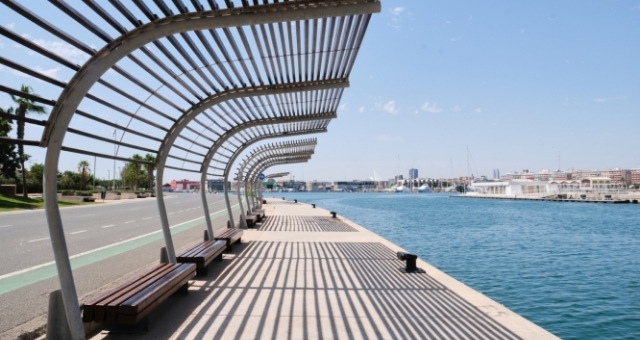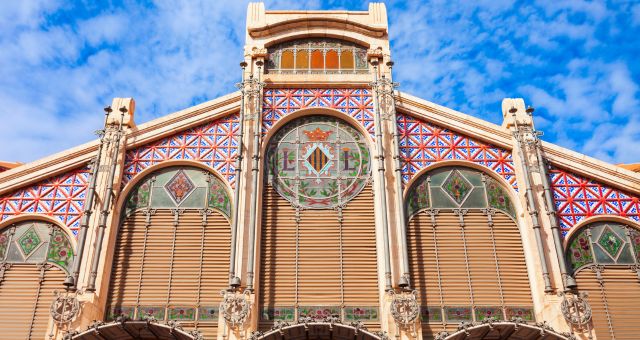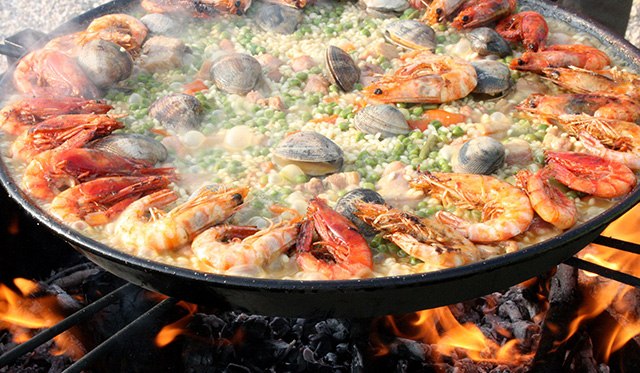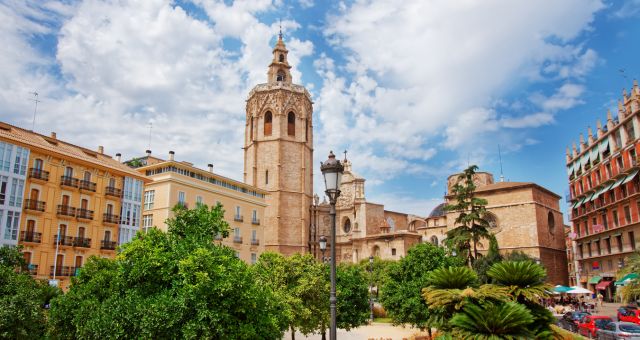Valencia
Valencian Community, SpainValencia is a vibrant port city on the east coast of Spain and is famous for its culture, architecture and delicious paella. Read Ferryhopper's travel guide and discover useful info about the ferry port of Valencia, as well as travel tips about holidays in the city. Compare prices and book ferry tickets online from Valencia to the Balearics and Algeria with no hidden fees!
Find useful info about:

The majestic ferry port of Valencia
Valencia ferry port
The port of Valencia is one of the main gateways to the Balearic Islands and one of the busiest cargo ports in the Mediterranean Sea. The port of Valencia has an information point for travelers, duty-free shops, restaurants and cafes, as well as a parking area.
There are 3 main passenger terminals for ferry departures: the Muelle de Poniente which normally serves Trasmediterránea ferry routes, the Muelle del Turia, which mainly serves Baleària crossings, and the Muelle Perfecto Palacio where GNV operates.
Useful info: the port of Valencia has approved the construction of a new modern, eco-friendly passenger terminal between the Muelle de Poniente and the Muelle Perfecto Palacio.
Ferries from Valencia port
There are ferry connections from Valencia to the islands of Mallorca, Ibiza and Menorca, as well as to Mostaganem in Algeria. Routes are usually served by 3 ferry companies and are in operation throughout the year. In the summer months, crossings from Valencia are more frequent.
We recommend booking your ferry tickets from Valencia as early as possible, especially if you are transferring your car or motorcycle by ferry.
Ferries from Valencia to the Balearics
There are regular ferries from Valencia traveling to the Balearic Islands. Below, you can find detailed information about Valencia crossings:
- Ferry from Valencia to Mallorca: the Valencia - Palma de Mallorca ferry crossing is one of the most popular. The Valencia - Mallorca ferry route is available with at least 3 daily sailings and the ferry duration is approximately 7-10 hours.
- Ferry from Valencia to Ibiza: ferries from Valencia to Ibiza are regular throughout the year with more than 10 weekly sailings. The ferry trip duration ranges between around 5 and 7 hours.
- Ferry from Valencia to Menorca: there is usually 1 weekly ferry from Valencia to Menorca. Τhe duration of the ferry ride is around 16 hours.
Valencia ferries to Algeria
From the port of Valencia, you can travel to Algeria in North Africa. Ferries from Valencia to Mostaganem in Algeria are usually available once per week and the ferry crossing lasts about 14.5 hours.
Tip: on our Map of ferries, you can find all available routes and ferries from Valencia and easily book your trip to the Balearics and Algeria!
Where is the ferry port in Valencia?
The ferry port of Valencia is in the neighborhood of Poblats Marítims. It is located around 5 km southeast of the city center, close to several restaurants, shops and more traveler services.
How to get to Valencia ferry port?
Valencia's ferry port is well connected to the city and you can easily get there by car or public transport. The port of Valencia is connected to the national road network via the V-30. Alternatively, the closest subway stop is Grau Canyamelar on Line 5. You can also hop on one of the local bus routes: 4, 30, 95, and N8.
In addition, you can get to the port on foot, by taxi or by a shuttle bus that takes passengers to the ferry terminals.

Passenger waiting area at the port of Valencia
Holidays in Valencia
Valencia is the third-largest city in Spain and it is known for its impressive architecture, important cultural heritage and, of course, its delicious food! It is a great destination if you like history and the arts, while close to the center of the city, you can also find beautiful beaches for swimming and sunbathing.
Valencia is a year-round holiday destination with great weather, thanks to its mild Mediterranean climate. It has around 300 sunny days per year! If you're wondering how many days you should spend in Valencia, we recommend at least 3 nights in order to get a sense of the city’s lively vibe and local culture.
How to get to Valencia
You can get to Valencia by car, train, bus or plane from other cities in mainland Spain, as well as from European and international destinations.
The airport of Valencia is located in Manises, about 10 km from the city center, which is roughly 15 minutes by car or 30 minutes by public transport. You can also get to Valencia by ferry from the Balearic Islands or from Algeria in North Africa.

Sunset colors over the city of Valencia
What to do in Valencia
Valencia is a beautiful capital city on the east coast of the Iberian Peninsula. It’s a modern destination that combines grandiose architecture with historical sights and impressive gardens.
We recommend exploring the city on foot or renting a bicycle to visit as many of its top sights as you can. Stroll around the characterful old town of Valencia and discover picturesque alleys and bohemian neighborhoods, such as the Barrio del Carmen.
If you are traveling with your family and kids, you can visit the aquarium of Valencia, which is housed in an impressive building in the City of Arts and Sciences, and features the longest underwater tunnel in Europe! During your stay, you should also try the authentic paella valenciana, the signature dish of the region!
If you are staying longer, we recommend exploring the region of Valencia. There are some amazing beaches on the coast as well as some beautiful inland hiking trails.
Discover more about the city in our Valencia travel guide below.
Beaches in Valencia
The coast of Valencia has a variety of sandy beaches to choose from, depending on how close you want to be to the center of the city. The majority of beaches in Valencia are long with golden sand and clear blue waters.
On the beaches that are close to the port of Valencia, there are umbrellas and sunbeds, while you can also enjoy food or drinks at nearby seaside restaurants and beach bars.
Some of the best beaches in Valencia are:
- La Malvarrosa: this is the most popular beach in Valencia, as it’s the closest to the city. It is sandy and long with umbrellas and sunbeds. It’s family-friendly and you can access it by bus, tram or on foot.
- Playa del Cabanyal (Las Arenas): it is the closest beach to the port of Valencia, located right next to La Malvarrosa. It's a long, sandy beach with canteens, beach bars and an exclusive beach club.
- Playa Saplaya: this is a sandy beach located about 4 km from the center of Valencia. Saplaya is easily accessible by bus or bike. It is right next to the picturesque harbor of Saplaya against a beautiful background, with many shops and restaurants nearby.
- El Saler: located about 12 km south of the center of Valencia, El Saler is a beautiful and long beach surrounded by sand dunes. It’s part of the La Albufera Natural Park so you can go on short nature walks around the coast or organize a boat trip to the nearby lake.
- Platja del Perelló (Playa del Perellonet): this is a long sandy beach located about 25 km from the center of Valencia. In the morning hours, the beach is perfect for families with kids or for anyone who wants quiet time by the sea. In the afternoon, the beach is ideal for windsurfing and kitesurfing, due to the changes in wind direction.
- Sagunto: it is a family-friendly beach with golden sand located about 30 km from the city center. You can reach the beach by train from Valencia. The beach is also accessible for people with disabilities.
- Cullera: this is a series of sandy beaches in the small coastal town of Cullera. Located about 45 km from the center of Valencia, it’s ideal if you want to escape the big city crowds and enjoy peaceful beach vibes and good food.

The promenade towards La Malvarrosa beach at the coast of Valencia
Activities in Valencia
Valencia offers many different kinds of activities depending on your style, budget and the type of holidays you’re dreaming of.
Here are some suggestions for activities in Valencia by the Ferryhopper team:
- If you're staying in the city of Valencia, we recommend renting a bike to explore the City of Arts & Sciences, as well as the parks and seafront promenades. The prices for renting a bike are usually around €10 per day, while you can also book an organized bike tour with a tourist guide.
- The city of Valencia is also great for shopping! It has numerous fashion stores, boutiques, artisan shops, and food markets.
- If you like outdoor activities and are interested in exploring the region of Valencia, we definitely recommend hiking. Some of the best hiking trails in Valencia are in La Albufera National Park, a beautiful and large freshwater lagoon, about 25 km from the city.
- A great day trip from Valencia is to Montanejos hot springs and waterfalls. It's about a 1.5-hour drive from Valencia.
- If you are a food-lover, then you can try one of the paella cooking classes and learn how to make the traditional Spanish dish in its place of origin.
Sightseeing in Valencia
Valencia is one of the oldest cities in Spain and it has a significant history that is evident in the city's monuments, fabulous buildings and cultural sights. Just strolling through Valencia and observing its architecture is a great way to experience the multiple cultural influences the city has had during its long history.
Here are some suggestions for sightseeing while in Valencia:
- City of Arts and Sciences (Ciudad de las Artes y Ciencias): this is an impressive architectural complex in a 2 km-long area on the old Turia river bed. It was designed by Santiago Calatrava and it's one of the largest scientific and cultural complexes in Europe, housing a science museum, an opera house, a planetarium, and an aquarium.
- La Lonja de la Seda: this UNESCO World Heritage Site in the historical center of Valencia is a masterpiece of Gothic architecture.
- The Cathedral of Valencia: the beautiful gothic Cathedral of Valencia was built in the 13th century. We recommend climbing the 207 steps of the Miguelete tower for the best panoramic views of the city.
- L'Oceanogràfic: the oceanarium (seawater aquarium) of Valencia is an impressive building in the City of Arts and Sciences and a must-visit if you are traveling with kids. It hosts 45,000 individual animals from 500 different species, including sharks, beluga whales, jellyfishes, and flamingos.
- Jardín del Turia (Turia Gardens): it's one of the most impressive urban parks in Spain with a great variety of trees and plants, as well as sports facilities. It is a favorite among runners and cyclists, while it's also great for picnics and long walks.
- El Mercado Central (Central Market): as one of the oldest food markets in Europe, the central market of Valencia is an emblematic modernist building where you can find some of the best local delicacies.
- The Museum of Fine Arts of Valencia: the second largest art gallery in Spain, with works from the 15th to the 19th centuries.

The beautiful Central Market of Valencia
Nightlife in Valencia
Valencia has a vivid nightlife with atmospheric bars, clubs, live music venues, and discos. The neighborhood of El Carmen in the historical center is one of the most popular and liveliest areas to go out at night in Valencia. Another trendy area, especially among the young, hipster and artistic crowd, is the former working-class district Ruzafa, thanks to its fusion restaurants, chic cocktail bars and independent breweries.
If you want to have a more relaxing drink in a nice environment, you can choose the bars and restaurants at Plaza de Cánovas. The area around Avenida d'Aragó is great if you want to listen to live bands or dance to Latin music.
During the summer, the port of Valencia and the beach of Malvarrosa are great spots for a cocktail with a beautiful view of the sea or for dancing until the early morning hours.
Food in Valencia
In Valencia, you will get the chance to eat delicious Mediterranean food! There are many restaurants, bars and street food markets where you can try Valencian cuisine and local products.
The two most famous dishes that you definitely have to try during your vacation in Valencia are paella and fideuà.
- Paella is one of the most well-known Spanish dishes across the globe, and this mouthwatering recipe actually originates from the city of Valencia. The traditional paella valenciana is usually cooked with rabbit, chicken and white beans, while the seafood paella is a rather common and tasty alternative.
- Fideuà originates from the nearby city of Gandía and you can try it in many restaurants in the Valencian region. It is prepared with thin noodles and seafood.
If you have a sweet tooth, then you should definitely try bunyols, horchata and fartons.
- Bunyols (or buñuelos) are sweet pumpkin fritters, similar to donuts. They are sprinkled with sugar and they are the typical snack of the Las Fallas festival. You can also try them dipped into thick hot chocolate.
- Horchata is a dairy-free milk that is usually served cold or iced. It is often combined with freshly baked fartons, a brioche-type pastry with sugar on top. One of the best places to try horchata and fartons is Horchatería Santa Catalina in downtown Valencia.

Sizzling hot seafood paella, a staple of Valencian gastronomy
Valencia tips
Before you book your trip, here are some useful Valencia travel tips to check out:
- If you happen to visit Valencia in the middle of March, you can experience the ecstatic festival of Las Fallas. For more than 5 days, the whole city celebrates in honor of Saint Joseph (San José). These festivities include a firecracker show called mascletà, the creation and destruction of huge (mostly satirical) statues called ninots, as well as parades and street parties.
- Apart from the amazing festival of Las Fallas, Valencia lights up again in June during the Festival de les Arts, held in the City of Arts and Sciences.
Springtime is considered to be the best period to visit Valencia, especially if you plan to do a lot of sightseeing. - If you are traveling to Valencia with kids, we recommend visiting the Parque Gulliver, an attraction inspired by the classic book Gulliver’s Travels. Kids can play on slides, ramps, a giant chessboard, and the skating area, and even try the mini-golf course.
- For wine-lovers, consider booking a day trip combined with a wine tour in the wineries of the Valencian countryside.
- If you are a dance aficionado or into classical music, we recommend watching a performance at the Palau de les Arts Reina Sofía opera house, renowned for its impressive architecture.
Useful information about Valencia
Valencia is a large city with modern infrastructure and everything you might need for a comfortable stay. The center of the historic district is Ciutat Vella, where you can find plenty of shops, bars, cultural and historical sights, and museums. The areas of Velluters, El Pilar and El Mercat are the commercial heart of the city.
There are several hospitals in Valencia, mainly in the suburbs, while there are a few medical clinics in the city center.
Regarding accommodation in Valencia, there is a great variety of hotels, luxury apartments and bed & breakfasts. One of the most popular locations to stay in the city of Valencia is Ciutat Vella. There are also seaside resorts across the coast, while on the outskirts of the city, you can find campgrounds and camping resorts.
If you are looking for accommodation away from the city crowds, then you could check out the hotels and apartments in the nearby town of Cullera.
Important phone numbers for your stay in Valencia
Here are some useful contacts to keep handy during your trip to Valencia:
- Valencia Port Authority: +34963939500
- Valencia Bus Station: +34963466266
- Local Police: 092
- Valencia General Hospital: +34963131800
- Taxi services: +34963571313
- Valencia International Airport (Manises): +34913211000
- Late-night pharmacy: +34900500952
- European emergency number: 112
Transportation in Valencia
Valencia has a great transportation network that includes metro, tram and bus services that connect the center of the city to the coast and its suburbs. To get around Ciutat Vella, it's easier to walk, cycle or use buses. In Valencia, the metro is more convenient when you want to travel between different neighborhoods of the city.
If you are planning to move around Valencia by public transport, we suggest buying a Valencia Tourist Card. The card offers unlimited entry on buses, metros and trams, as well as special rates and discounts for museums and monuments. Depending on the duration of your stay, you can choose between the 24, 48 or 72 hours card. Prices start at around €14.
Tip: Valencia has its own bicycle borrowing scheme called Valenbisi, which lets users borrow bikes and return them at various locations throughout the city.

The Cathedral of Valencia and its Miguelete tower
Book ferry tickets online to Valencia
On Ferryhopper, you can book ferry tickets from/to Valencia online with just a few clicks. Read our Valencia travel info, search for the available ferry routes and connections, compare companies and prices, and book your trip hassle-free!
Valencia ferry schedule
View the complete ferry schedule from and to Valencia for the upcoming week. Find up-to-date trip information, including departure and arrival dates and times, ferry operators and ticket prices.